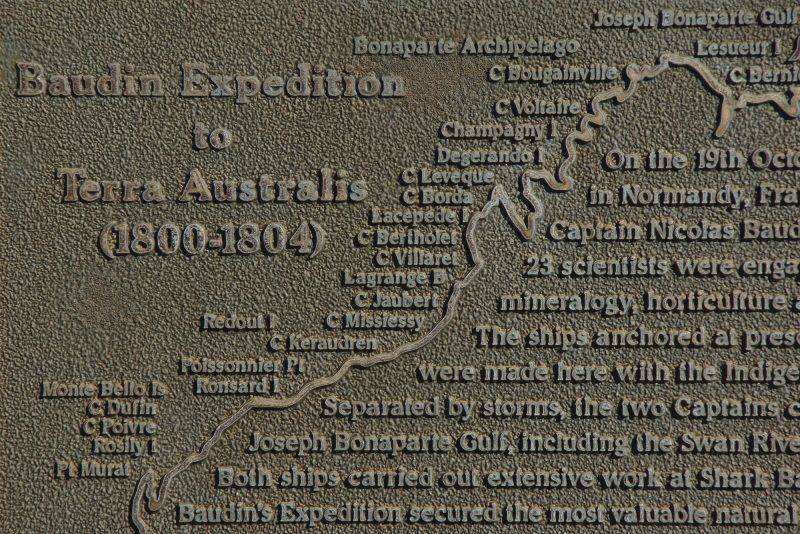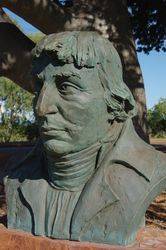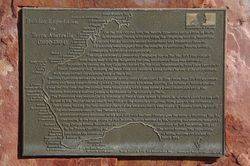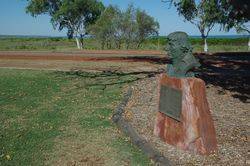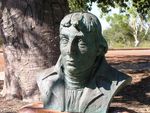
Home » Themes » Landscape » Exploration
Baudin ExpeditionPrint Page 
The bust of Nicholas Baudin commemorates the bicentennial of the Baudin Expedition.
Nicolas Baudin was selected to lead an expedition to survey the coast of Australia and while there to carry out scientific investigations. He sailed in October 1800 with two ships, Le Géographe and Le Naturaliste, but it was not until May the following year that he sighted the west coast of Australia. The expedition spent about three months in Western Australian waters, charting parts of the coast and collecting scientific data.
After visiting Timor for supplies, Baudin turned his attention to southern Australia, giving many French names to what he called Terre Napoléon. He also explored the east coast of Tasmania and in April 1802 met Matthew Flinders by chance in Encounter Bay on the South Australian coast. During his expedition, Baudin secured the most valuable natural history collection of its time, collecting more that 200,000 species of flora and fauna.
Location
| Address: | Hamersley & Weld Streets, Bedford Memorial Park , Broome, 6725 |
|---|---|
| State: | WA |
| Area: | AUS |
| GPS Coordinates: | Lat: -17.96295 Long: 122.238978 Note: GPS Coordinates are approximate. |
Details
| Monument Type: | Sculpture |
|---|---|
| Monument Theme: | Landscape |
| Sub-Theme: | Exploration |
Dedication
| Actual Monument Dedication Date: | Friday 13th December, 2002 |
|---|
Plaque :
Government Of France
Baudin Expedition
To
Terra Australis
(1800-1804)
On the 19th October 1800, the Baudin Expedition set sail from Le Havre in Normandy, France, with two ships, the Geographe and the Naturaliste. Captain Nicolas Baudin's second-in command was Emmanuel Hamelin. 23 scientists were engaged from the domains of astronomy, botany, zoology, mineralogy, horticulture and geography.
The ships anchored at present day Geographe Bay on 31st May 1801. First contacts were made here with the indigenous peoples. Midshipman Vasse was drowned. Separated by storms, the two captains charted the WA coast independently, from Cape Leeuwin to Joseph Bonaparte Gulf, including the Swan River and Heirisson Island, named for one of the Ship's officers. Both ships carried out extensive work at Shark Bay.
Baudin's Expedition secured the most valuable natural history collection of its time- more than 200,000 specimens of flora and fauna were collected of which 2542 were new to science, doubling the number of known species. It was the first time live animals were transported, which later formed a small Australian zoo at the Empress Josephine's summer palace at Malmaison on the outskirts of Paris.
The expedition was responsible for hundreds of French place names in Australia, of which about 240 are still in use in WA. Baudin charted nearly two thirds of the Australian coastline, filling gaps in the rudimentary Dutch maps, making the first detailed charts of the west and north coasts of Western Australia and of the south-eastern coast of Van Diemen's Land.
A celebrated chance encounter on 8th April 1802 with Matthew Flinders gave the name to Encounter Bay, SA. After resting in the young colony of Port Jackson, Baudin returned to WA, carrying out extensive research at King George Sound. Baudin died of tuberculosis on 16th September 1803 at Ile de France (Mauritius) on the return journey. The expedition, now under the command of Milius returned to Lorient in Brittany in March 1804.
Terra Australis 2001 WA Association Inc
Centenary of Federation Western Australia


